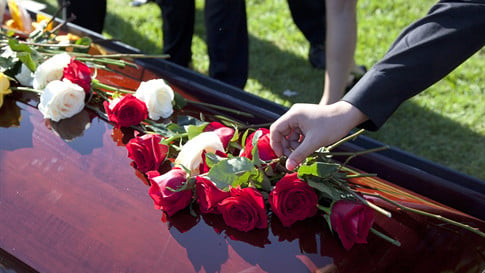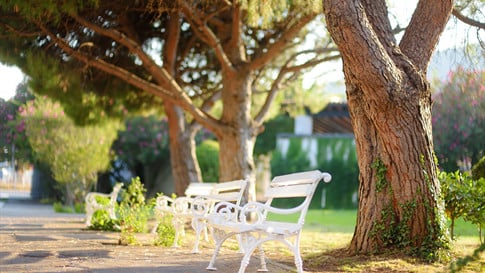About Us
Celebrating life since 1962
By 1968, Chapel Hill Mortuary began operating at this same location in Cedar Hill, representing the relocation of the
original Brimmer Funeral Home from downtown House Springs, Missouri.
In 2010, we began operating Oak Hill Cemetery in Kirkwood, Missouri which has an extraordinary history dating to 1835.
At this same time, we began operating the funeral home on-site at this Kirkwood location which represented
the original funeral operations of Pfitzinger Funeral Home, from downtown Kirkwood, Missouri.
By 2014, we purchased both the cemetery and funeral home operations at this Kirkwood location.
In 2016, we purchased a very prominent cemetery in Bonne Terre, Missouri known as St. Francois Memorial Park
and re-opened a funeral operation at this location, as well.
Today, we retain all of the history and records while operating of each of these three (3) cemeteries.
Each cemetery has a well funded and audited Endowed Care Trust with the State of Missouri.
The funeral homes are operated under the name of Chapel Hill Mortuary at each of these locations.
Our promise
Today, tomorrow, and forever, our commitment to you stays the same.

Dignity
Every life is unique, and we promise to honor and respect each journey, crafting ceremonies that reflect each individual.

Guidance
Navigating grief can be overwhelming; we stand by you, providing direction and solace every step of the way.

Legacy
Beyond a service, we're committed to helping families create lasting tributes that transcend generations.
Our story
In 2010, we began operating Oak Hill Cemetery in Kirkwood, Missouri which has an extraordinary history dating to 1835. At this same time, we began operating the funeral home on-site at this Kirkwood location which represented the original funeral operations of Pfitzinger Funeral Home, from downtown Kirkwood, Missouri.
By 2014, we purchased both the cemetery and funeral home operations at this Kirkwood location.
In 2016, we purchased a very prominent cemetery in Bonne Terre, Missouri known as St. Francois Memorial Park and re-opened a funeral operation at this location, as well.
Today, we retain all of the history and records while operating of each of these three (3) cemeteries. Each cemetery has a well funded and audited Endowed Care Trust with the State of Missouri. The funeral homes are operated under the name of Chapel Hill Mortuary at each of these locations.
12K+
Legacies Honored
61
Years in Business
1M+
Moments Remembered
Our incredible staff
Helping families create lasting legacies is more than a job — it's our calling. We are here to support you in any way we can and will offer you the full attention, knowledge, and compassion you need.

Keisha Davis
Funeral Team

R.J. Franklin
Cemetery Team

Ben Bailey
Cemetery Team
1 of 20

Brian May
Owner & President
Brian May was raised in Cedar Hill, Missouri and graduated from Northwest High School. He received a Bachelor of Arts in Finance from the University of Illinois in Champagne-Urbana, Illinois. He has great memories of friendships and work experience at his first full-time job with Commerce Bank in St. Louis, Missouri before joining his parents, Bill & Sandy May, at Chapel Hill in 1993 and completing his Associates Degree in Funeral Service from Forest Park Community College in St. Louis, Missouri.
Today, Brian owns and is active in the operation of three (3) funeral homes that are each located on three (3) cemeteries in Cedar Hill, Kirkwood and Bonne Terre, Missouri, plus a funeral operation specifically focused on cremation.
Brian maintains the following professional licenses and accreditions:
Missouri Licensed Funeral Director
Missouri Licensed Embalmer
Missouri Licensed Preneed Agent
Missouri Licensed Life Insurance Producer
Certified Acute Loss Expert
Certified Funeral Celebrant
Certified Crematory Operator
Brian is married to Amy Hofstetter May and they live in Jefferson County, Missouri with their daughter, Audrey, and their son, Will.

Sandy May
Cherish Outreach
Sandy May was raised in St. Louis, Missouri and graduated from Lindbergh High School. She received a Bachelor of Arts from SIU Carbondale in Carbondale, Illinois and returned to Lindbergh High School to teach, briefly, before meeting her husband and joining Bill May at Chapel Hill.
After more than 50 years, Sandy remains very active with Cherish, a non-profit which provides free grief support and community outreach.
Sandy maintains the following professional licenses and accreditations: Missouri Licensed Funeral Director
Sandy is married to Bill May and they live in Jefferson County, Missouri. Bill enjoys his retirement from Chapel Hill. Sandy and Bill have three (3) children, William May, Brian May and Susan VonderHaar - along with four (4) grandchildren, Audrey, Will, Wolfgang and Stella.

Samantha Hofstetter
Cherish Outreach
Samantha Hofstetter, in her role as the Community Outreach Coordinator for Cherish, brings a wealth of experience and dedication to her work. With a commendable five-year tenure at Chapel Hill, Sam's commitment to fostering community connections is evident. Her personal life is anchored in a loving marriage to Matt Hofstetter, and together, they share the joys and responsibilities of raising three children, Luke, Holt, and Tate. Family moments are enriched by the presence of their two cherished dogs, Adi and Merle. Sam's leisure time finds fulfillment in the art of discovery—whether through shopping or antiquing, hobbies that speak to her appreciation for the stories woven into unique finds. Her ability to balance professional engagement with a fulfilling family life and personal interests defines Sam's enriching journey.

Susan VonderHaar
Finance & Human Resources
Susan VonderHaar was raised in Cedar Hill, Missouri, and graduated from Northwest High School. She received a Bachelor of Arts from the University of University of Missouri, St. Louis, and a Masters Degree in Communication from Saint Louis University. She taught communication courses at community colleges throughout St. Louis before joining her parents and brother, Bill & Sandy May and Brian May, at Chapel Hill.
Today, Susan is responsible for the financial bookkeeping and reporting, along with human resources and compliance, for all three Chapel Hill locations.
Susan is the grant writer and Treasurer on the Board of Directors for CHERISH, our community, mental health non-profit.
Susan maintains the following professional licenses and accreditations:
Quickbooks Professional Certification
Susan lives in Jefferson County, Missouri with her son, Wolfgang, and her daughter, Stella.

Bryan Harter
Funeral Planning
Bryan was raised in St. Louis, Missouri and graduated from Oakville High School.
Bryan helps families throughout the community plan for healing with intentional funeral planning that includes cemetery, monument, funeral and cremation services.
Bryan maintains the following professional licenses and accreditations:
Missouri Licensed Preneed Agent
Missouri Licensed Life Insurance Producer
Certified Acute Loss Expert
Bryan is married to Lana Harter and they live in West St. Louis County, Missouri with their two daughters.

Steffanie Hermann
Funeral Planning Team
Steffanie was raised in High Ridge, Missouri and St. Louis, Missouri and graduated from Oakville High School. She has great memories of friendships and work experience at her previous career with Jenny Craig in St. Louis, Missouri before beginning a career in funeral planning and joining Chapel Hill.
Today, Steffanie helps families throughout the community plan for healing with intentional funeral planning that includes cemetery, monument, funeral and cremation services.
Steffanie maintains the following professional licenses and accreditations:
Missouri Licensed Preneed Agent
Missouri Licensed Life Insurance Producer
Certified Acute Loss Expert
Steffanie is married to Scott Hermann and they live in Jefferson County, Missouri with their son, Nathan, and their daughter, Samantha.

Michelle Ellis
Client Services
Michelle was raised in Dittmer, Missouri and graduated from Northwest High School. She has great memories of friendships and work experience at her job with Soccer Park in Fenton, Missouri before joining Chapel Hill.
Today, Michelle is responsible for Sales Administration at Chapel Hill including marketing and database management.
Michelle is married to Scott Ellis and they live in Jefferson County, Missouri.

Jesse Lewis
Funeral Team
Jesse A. Lewis is a seasoned professional in the field of funeral services, having held a Missouri Funeral Director license since 2015. His tenure at Chapel Hill Mortuary since 2009 speaks volumes about his commitment and expertise in guiding families through challenging times. Beyond his dedicated profession, Jesse finds fulfillment in his roles as a loving husband to Kayla and a devoted father to their son, Ben. Embracing adventure, Jesse enjoys the thrill of racing motocross, working on anything with wheels and cherishes weekends spent on the lake with his family. His balance between professional excellence and cherished personal pursuits defines his enriching life.

William May
Funeral Team Lead
William May II, a man of distinction and accomplishment, traces his roots back to Northwest High School, where he laid the foundation for a remarkable journey. Born into the legacy of the founders of Chapel Hill Mortuary, William inherited a deep sense of tradition and community responsibility.
His academic pursuits led him to Bradley University, where he earned a degree in Human Resources Management, setting the stage for a fulfilling career in operations for global corporations. California became his professional playground, where he resided for an impressive 32 years, contributing to the dynamic landscape of business on a global scale.
In the realm of personal joys, William's heart found its true companion in the late Robert Taff. Their love story culminated in a joyous union on July 4, 2013, amidst the vibrant energy of West Hollywood, California. This partnership endured for a decade after 32 years of shared life. Sadly, Robert Taff, hailing from St. Louis, bid farewell on March 4, 2022, finding eternal repose in the May family mausoleum at Chapel Hill Memorial Gardens.
William's commitment extends beyond the professional and personal spheres. An ardent supporter of Jack Russell Rescue, he adopted and raised four Jack Russells, exemplifying his compassion for animals. William's love for exploration and cultural enrichment is evident in his extensive travels to multiple countries, where he has savored the diverse flavors of the world as a self-proclaimed foodie.
Balancing his love for culinary delights, William also enjoys maintaining a healthy lifestyle through regular workouts. His dedication to both personal well-being and philanthropy showcases a holistic approach to life. In essence, William May's journey is one marked by academic achievements, professional success, enduring love, and a commitment to making a positive impact on the lives of both humans and animals, and the local and global communities he touches.

Jenna Rasmussen
Funeral Team
Jenna Rasmussen, a Licensed Missouri Funeral Director and dedicated Apprentice Embalmer, originates from the heart of Bland, Missouri. Her commitment to the funeral service industry was solidified with the attainment of an AAS in Funeral Services Education from St. Louis Community College in May of 2023. Beyond her professional pursuits, Jenna finds solace and joy in the simple pleasures of life, relishing moments spent with cherished family and friends. Her love for uncovering treasures from the past manifests in her hobbies of antiquing and curating a collection of all things vintage. Jenna's blend of professional dedication and appreciation for life's nostalgic nuances shapes a well-rounded and fulfilling existence.

Todd Nichols
Funeral Team
Todd is from St. Louis, Missouri and graduated from John A Gupton college of mortuary science in 2014 in Nashville, Tennessee. After doing his apprenticeship in his hometown he moved to Alaska in September 2017 and began working at Legacy Funeral Homes. In 2023 he returned back to his hometown in Missouri, where he joined the team at Chapel Hill Mortuary. He is a baptized member of the Lutheran Church-Missouri Synod.

Isabelle Steinlage
Funeral Team
Isabelle Steinlage joined the Chapel Hill family in October of 2023. She proudly graduated from Ursuline Academy High School in 2018 before attending St. Louis University’s School of Nursing from 2018-2020. In 2023, Isabelle achieved a significant milestone by graduating from St. Louis Community College with an Associate’s Degree in Funeral Service Education, an achievement marking a transition in her career path and signifying her commitment to a life devoted to funeral service.
Prior to joining Chapel Hill Mortuary, Isabelle spent several fulfilling years as a nanny to some truly incredible children. Beyond her professional pursuits, she finds joy in reading books and spending quality time with her family and friends. Isabelle hopes that as she continues her journey in funeral service, her compassionate spirit and commitment to supporting others during challenging times will leave a lasting impact on all the lives she touches.

Rob Bohle
Funeral Team
Rob spent the majority of his professional life at Southwestern Bell, where he contributed his skills and expertise for many years. After this successful career, he transitioned into a new chapter of his life in 2003 when he joined Chapel Hill Mortuary. Rob and his wife, Nancy, raised two children in Cedar Hill.
Charles Wigger
Funeral Team
Charles Wigger, commonly known as Charlie, is a dedicated individual whose journey has been marked by hard work, commitment, and a passion for community. Born and raised with a strong work ethic, Charlie found himself drawn to the skilled profession of bricklaying, where he honed his craft over an impressive 30-year career with the Brick Layers Union.
In 2017, after three decades of unwavering service, Charlie decided to embark on a new chapter in his life. Retirement beckoned, but rather than slowing down, he sought out fresh challenges and opportunities to contribute to the community in meaningful ways. This led him to Chapel Hill, where he joined in 2018, bringing his wealth of experience and expertise to a new environment.
Beyond his professional endeavors, Charlie finds joy and relaxation on the golf course, where he shares laughs and camaraderie with friends. His love for golf is not just a pastime but a reflection of his sociable nature and appreciation for the finer moments in life.
At the core of Charlie's world is his beloved wife, Christina. Together, they navigate life's journey, sharing its joys and triumphs. Their partnership is a testament to enduring love and mutual support.

Alyssa Stough
Client Services
Alyssa Stough serves on the Client Service Team at Chapel Hill Mortuary, displaying a remarkable blend of professionalism and organizational prowess in her role. A graduate of Pattonville High School's class of 2019, Alyssa's dedication to her career is matched only by her devotion to her son, Clay. Beyond her work commitments, Alyssa finds joy in the vibrancy of life, often immersing herself in the rhythmic beats of concerts and relishing moments spent with cherished friends and loved ones. Her love for literature fuels her leisure hours, as she finds solace in the pages of books, and she expresses her creativity through various forms of art. Alyssa's multifaceted interests and commitment to both family and personal growth shape a rich and fulfilling life.

Caitlyn King
Client Services
Caitlyn is a spirited individual from St. Louis who graduated from Windsor High School in 2020, marking the beginning of new adventures. After graduation, Caitlyn delved into the world of caregiving through her work at a daycare before joining Chapel Hill Mortuary in client services. She finds solace in the world of books, as reading is not just a pastime, but a source of inspiration and personal growth. As she continues to navigate her path, one can expect Caitlyn to bring the same passion for learning and caring to every chapter of her life.

Rebecca Byerley
Client Services
Rebecca Byerley, affectionately known as Gigi by her beloved grandchildren, is a woman with a rich tapestry of life experiences. With over two decades of retail expertise under her belt, Rebecca has mastered the art of customer service and management, bringing a blend of professionalism and warmth to every interaction.
In addition to her retail career, Rebecca spent twelve impactful years working in a funeral home, demonstrating a remarkable ability to provide solace and support to those in their most challenging moments. Her compassion and empathy during this time left a lasting impact on the lives she touched.
Beyond the formal realms of work, Rebecca has also embraced the call of duty, having dipped her toes into the world of firefighting. Her courage and commitment to public service showcase her unwavering dedication to making a positive impact on her community.
Away from the hustle and bustle of professional life, Rebecca finds solace in the great outdoors. Whether tearing through rugged trails on a four-wheeler or basking in the tranquility of a pool, she cherishes every moment spent in nature. However, her greatest joy comes from being with her family, especially her grandchildren, whom she spoils with love and affection.
Rebecca is not only a dedicated professional but also a devoted member of her church community. Whether attending services or actively participating in church activities, her faith plays a central role in her life, guiding her actions and interactions.
In every facet of her life, Rebecca Byerley embodies the values of compassion, dedication, and love. As a blended family matriarch and cherished Gigi, she leaves an indelible mark on the hearts of those fortunate enough to know her.
A place of healing
We welcome you to explore the Chapel Hill Mortuary, Funeral Homes & Cemeteries facilities, and invite you to discover a comforting and peaceful place to honor your loved one.







Seamless Arrangements
We'll help you with everything you need with a simple step-by-step process for all of your funeral, cremation and cemetery plans.

Unique Funerals and Tributes
Every individual is unique. Which is why we offer fully customizable memorial services designed just for your family.

Around the Clock Support
We're here to answer any questions and help in any way we can – 24 hours a day, 7 days a week, 365 days a year.
“Chapel hill mortuary have been very supportive of me during my time of grief in the passing of my mom”
Author:— Leslie Washington rated with 5 stars ★ ★ ★ ★ ★
“Great working with Brian, during a time like this you need a great company that you can depend on. Great work:!!!”
Author:— Langston Creative Group rated with 5 stars ★ ★ ★ ★ ★
“They are very kind, professional, compassionate, and understanding when dealing with a family's most tragic time.”
Author:— Jennifer Albertson rated with 5 stars ★ ★ ★ ★ ★
“Chapel Hill was very professional and extremely knowledgeable. Their kindness will be appreciated by my family.”
Author:— Dawn Stoltz rated with 5 stars ★ ★ ★ ★ ★
“Wonderful brunch!”
Author:— Berta Meyer rated with 5 stars ★ ★ ★ ★ ★
1 of 5 1 of 5

We're hiring
Beyond the opportunity to truly make a difference, Chapel Hill Mortuary - Funeral Homes & Cemeteries offers competitive pay, a healthy work-life balance, and many opportunities for growth.





